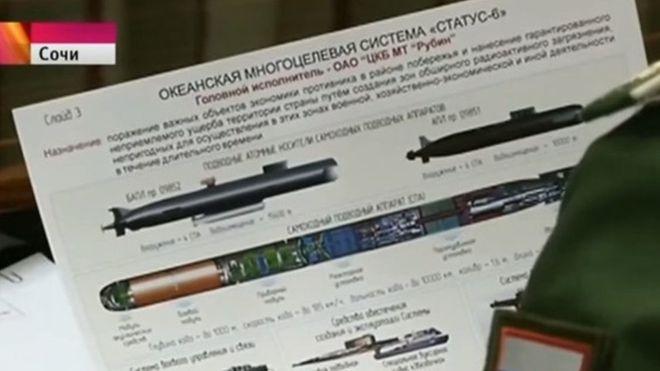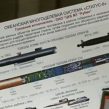
Russia Leaks Data About Doomsday Underwater Nuclear Drone
Publication: Eurasia Daily Monitor Volume: 12 Issue: 206
By:

President Vladimir Putin spent this past week vacationing in Sochi, just as this southwestern Russian coastal city was hit by an autumn storm and heavy rain. Russian government officials were forced to struggle to reach Sochi despite local flash floods because the president likes to combine rest at the Black Sea resort with important meetings that sometimes turn into multiday marathons. Notably, a three day-long defense policy meeting or “sovestchaniye” continued from November 9 to 11. It was, of course, top secret, but journalists were allowed in at the start of each day to hear Putin’s introductory speech. The first day, Putin praised the growing battle readiness of the Russian military, as demonstrated by the massive Tsentr (Center) 2015 exercises last September, which involved some 95,000 servicemen, as well as by the efficient deployment of and bombing campaign by Russian jets in Syria. At the same time, the Russian military is procuring new jets, armor, missiles and submarines, including nuclear; while the Russian defense industry is high-tech, Putin boasted. The Russian arms industry’s success is important for the entire nation and will be supported despite “the economic downturn,” he declared (Kremlin.ru, November 9).
On the second day, Putin blasted Washington for continuing to develop and deploy a global ballistic missile defense system (BMD), disregarding Moscow’s objections and “cooperation offers.” According to Putin, the United States is using the presumed North Korean and Iranian missile threats as a cover, while in fact “their [US] main aim is to militarily overwhelm Russia.” Moscow will respond by developing its own BMD and by “strengthening its nuclear offensive strategic forces that must be able to penetrate multilayer BMD.” Advanced strategic nuclear weapons are already being procured and deployed, the president stated (Kremlin.ru, November 10). Putin’s spokesperson Dmitry Peskov later told journalists: “Our BMD-related systems will be much cheaper than the American ones and more effective” (Interfax, November 10).
The bombshell fell on the third day, as Putin routinely read out his introductory remarks. The president announced that Russia is not trying to overcome anyone in some new arms race, but is merely rearming to catch up and compensate for time lost in the 1990s, after the end of the Cold War, when there was no money to procure new weapons or properly exercise troops. Today is different, and new weapons are being procured, but not always on time; more effort must be made in replacing foreign-made components as part of so-called “import-replacement,” which may, according to Putin, stimulate the innovation of the entire Russian industrial base (Kremlin.ru, November 11). As Putin continued to read from his stack of written notes, the audience’s attention shifted briefly to one of the generals present, who had lifted up from the table a large piece of paper with drawings and text. A TV cameraman, perhaps somewhat fatigued with constantly filming the same frame of Putin’s dull read-out, shifted the camera and shot a close-up of the chart in the general’s hands.
The footage was aired the same day by national TV broadcasters Channel One and NTV. In cases such as this, the president’s introductory remarks delivered ahead of closed-door meetings are most often captured by a Kremlin cameraman, and the filmed video is then distributed to national broadcasters for airing. On November 11, however, the footage apparently contained secret data that was readable on the chart held up by the Russian general, and it was shown on national television without a redaction. Peskov later admitted: “Secret data did, indeed, enter the camera’s frame. This must never ever happen again.” The authorities announced that, in the future, only President Putin will be in the frame on such occasions, and the camera will not be allowed to shift focus to take in anyone else present or any papers they may be holding (Interfax, November 11).
The leaked chart on the video contained data about the “Ocean Multipurpose System Status-6”—a massive torpedo-form underwater nuclear-powered unmanned drone, apparently developed by the St. Petersburg Rubin TsKP or Central Design Bureau, which designs most Russian nuclear submarines. The Status-6 unmanned underwater vehicle is designed to be attached to the outside hull and launched by a modified Oscar-2 type nuclear submarine and possibly other vessels. Due to it being nuclear powered, the Status-6 underwater guided drone can travel at a speed of up to 85 kilometers per hour (some 56 knots) and go as deep as 1 kilometer. It has a range of up to 10,000 kilometers. The Status-6 drone development was first reported by The Washington Free Beacon last September. In the Pentagon, the project is apparently known as Kanyon. The displayed chart describes Status-6 as a weapon designed to “destroy important economic coastal regions of the enemy and cause long-lasting massive radioactive contamination.” The speed and depth of the drone helps it penetrate US antisubmarine defenses and detonate close to the US’s Atlantic or Pacific coasts. Reportedly, the Status-6 drone can carry a 100-megaton superbomb: Detonating such a massive device underwater close to the coast could cause a gigantic, highly radioactive tsunami, destroying and contaminating large stretches of densely populated US territory, like New York, Los Angeles, Boston and so on, rendering these littoral areas uninhabitable for centuries or millennia. The Status-6 is planned for deployment by 2020 (The Washington Free Beacon, November 11; Aif.ru, November 12).
The Status-6 seems to be primarily a deterrence weapon that may further embolden the Kremlin to push for a new world order of its liking by intimidating the United States and its allies. Leaking data about a doomsday weapon is essential if it is to serve as an additional deterrence asset, but in this case it was done in an unorthodox way. The footage was apparently recorded and distributed by the Kremlin press service itself without redactions. Peskov promptly acknowledged the leak of secret data, thus making the news more trustworthy. In the end, the Status-6 might never actually be deployed—it is an absolutely immoral weapon, its military effectiveness is dubious, and the price of producing it could easily skyrocket. But even as an image on a piece of paper, it still can be used by the Kremlin as a bargaining chip to squeeze further concession from West.




